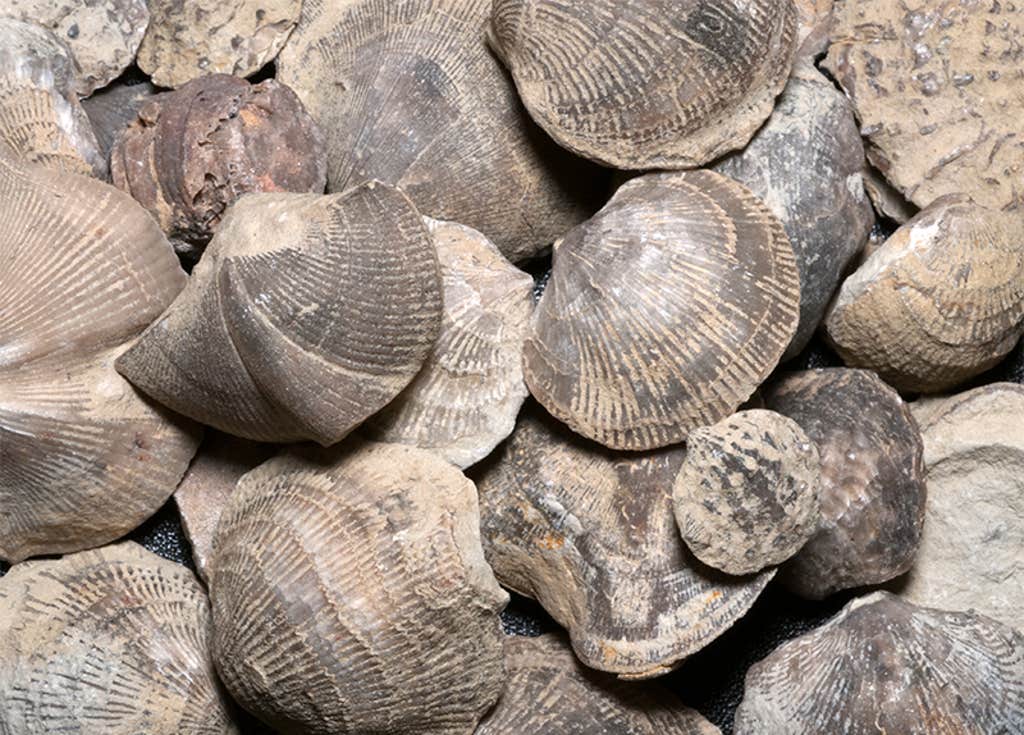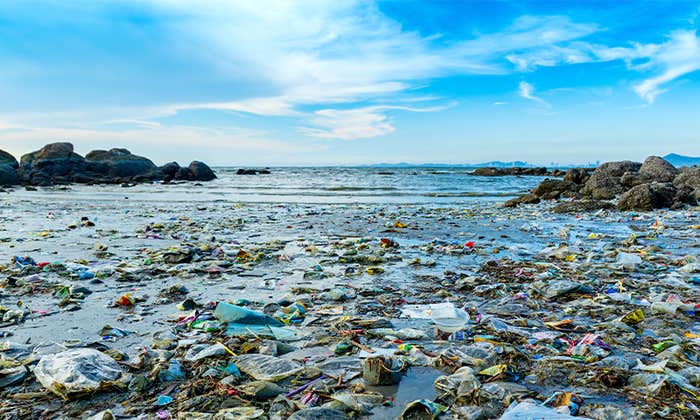Standing on the side of a mountain outside Santa Fe, New Mexico, I held evidence of the ocean. The rough gray rock was small and unimpressive, marked by a series of squiggly white lines; it was hardly worth Instagramming, much less taking home, but my daughter ran down the trail to bring me another, a little more articulated than the first, recognizably scallop-like. Her face was alight with excitement and her voice was thick with winter cold. “Mama,” she said, “I found a seashell.”
Nautilus premium members can listen to this story, ad-free.
Subscribe now to unlock Nautilus Narrations >
Nautilus members can listen to this story.
Subscribe now to unlock Nautilus Narrations >
We were hiking on the Chamisa Trail, part of the Dale Ball Trail System, which winds through the western foothills of the Sangre de Cristo Mountains. Here, the ground is red and the trees are sharp. Snow falls often in winter, blanketing the young mountains in white, obscuring the prickly pear paddles, leaving only the spines visible. I had read that sharp-eyed hikers could find fossils scattered throughout the region, but I didn’t expect it to be so easy, nor did I think my 4-year-old would be so fascinated by them.
Being able to situate oneself and one’s world as dots on an endless line is no small thing.
We had moved from Maine to New Mexico just months before, and we all fiercely missed the ocean, despite our growing admiration for the desert. We were still learning how to parent, teach, and play in this unfamiliar landscape with its deadly rattlers, punishing plants, and startling temperature swings. I pushed away memories of my former aquatic hobbies and tried to embrace the Land of Enchantment and its mystical vistas. And yet, here we were, collecting shells. “Just like in Maine,” my daughter said.
“Do you know how it got here?” I asked, crouching beside her in the mud. “There used to be a huge ocean here, right where we are standing.” It was all I knew, but it was enough for that moment. She looked around, up and down the trail. I like to think she was doing exactly what I was: wondering at the bigness and strangeness of our world.
Later, I find out that this fossil is “almost definitely from the Pennsylvanian,” according to Kevin Hobbs, field geologist and mapper for the New Mexico Bureau of Geology and Mineral Resources. The Pennsylvanian is what geologists call the period between 320 million and 300 million years ago. He identifies the fossil as a probable brachiopod.
“They are still around. You can go to the ocean today, and you’ll still find them,” he adds, though their heyday is long past. Most of the brachiopods who live today exist in deep, dark recesses of the ocean. Three-hundred million years ago, they were the main reef-builders and filter-feeders of their time. They dwelled in mud and on loose rocky shorelines, living their quiet lives alongside the equally staid clams and colorful corals. Around them moved predatory starfish and cartilaginous fish, early reptiles, and an abundance of amphibians.
While much of what is now northern New Mexico was covered with water, a chain of islands had begun to form, on which vibrant green life thrived: huge seed ferns, scale trees, and supersized club mosses. The oxygen-rich atmosphere enabled arthropods to grow to frightening dimensions. Six-foot-long armored insects scampered around the forests on their many, many legs, feasting on seeds, leaves, and spores. It’s likely that the crow-sized dragonflies found elsewhere at the time flitted around the Sangre de Cristos on their powerful wings, hunting for prey.

The Pennsylvanian gave way to the Permian, followed by the Triassic—when the first known dinosaurs appeared—and then the Jurassic and finally the Cretaceous, the Age of Dinosaurs, which ended about 66 million years ago. At Ghost Ranch in Abiquiu, New Mexico, an hour drive from the Sangre de Cristo mountains, I held the fossilized bone of a Coelophysis: a 9-foot-long bipedal meat-eating dinosaur who lived during the Late Triassic period. It was one of nearly 1,000 individual skeletons found in a quarry during the 1940s. The specimen was broken in half, and in the middle of the stone bone, I could see a pop of bright whitish-yellow quartz.
Standing in the Ghost Ranch’s Ruth Hall Museum of Paleontology, surrounded by bones and reproductions, I was able to better grasp how much our world had changed. On the day I visited in late May, temperatures registered in the 70s, but they felt much hotter. My nose was sunburnt, my throat was dry, my legs were scratched from walking among cacti. Yet here, again, was evidence that the southwest wasn’t always so. Some 200 million years ago, creatures who looked like sea dragons swam through the water above the mass grave of drowned bipedal dinosaurs. Life was expanding and changing, evolving.
Although there seems to be little shared between my tiny shell and the club-like Coelophysis leg bone, these various finds are pieces of a larger puzzle. Alongside the thousands of other fossils found in New Mexico, these objects helped form the bedrock of the tectonic plate theory. First postulated in the early 20th century, the theory only rose to prominence in the 1960s. The idea that the Earth was composed of moving layers—a hard, fragmented outer shell atop a molten core—was initially dismissed as fanciful. But the hypothesized movement of those plates provided a mechanism—the collision and overlapping of plates pushing Earth’s crust upward over millions of years—by which an ancient seabed could become a mountaintop. Geologists pointed to fossilized brachiopods and other marine creatures found at otherwise-inexplicable elevations to make their case.
“Prior to the plate tectonic theory, it was really difficult to explain how you get ocean fossils on top of the Sangre De Cristos,” explains Hobbs. He laughs when he talks about the “cockamamie theories” scientists once proposed about how shells ended up on summits. One idea was that there was once a lot more water on Earth, but it was boiled off into the air.
When Hobbs isn’t educating rock-curious members of the public like myself, he spends much of his time walking through arroyos and up mountains, mapping the geography of northern New Mexico. For him, awe comes easily. “It usually happens when I’m thinking about time and how long geologic time is,” he says.
Being able to situate oneself and one’s world as dots on an endless line is no small thing. Perspective, notes Maya Wei-Haas, a science writer and author of What a Rock Can Reveal,“is very difficult, especially when you’re young.” Knowing about the slow, long, strange processes that produce the rocks we find can help us better place ourselves in the big picture. It is both humbling and elevating, which, now that I think about it, is a good way to describe childhood in general.
In science, as in parenting, you don’t ever truly stop reaching or grasping.
Or maybe it’s just something we all struggle with equally. I had assumed that the vastness of billions of years and the massiveness of tectonic movements would be too much for my young child to grasp, but both Hobbs and Wei-Haas admit that they have trouble thinking along these lines, too. “This is something my wife and I argue about—whether you can understand geologic time,” says Hobbs. (For the record, his wife is also a geologist.) “I think you can,” he says. “But she says, ‘You just know the numbers.’” For Haas, this great philosophical question is “part of the fun” of geology. “It’s the almost-inconceivablity of it.”
But in science, as in parenting, you don’t ever truly stop reaching or grasping. The world is unknowable, kids are impossible, time is terrifically long, and our time is so very short. This may lead some to conclude that nothing matters—Hobbs said he’s met plenty of nihilist geologists who do precisely that—but that’s not the only way to interpret this set of facts. You could also look at them this way: Even the small things eventually add up to something great.
In Timefulness: How Thinking Like a Geologist Can Help Save the World, geologist Marcia Bjornerud argues that what she calls our “time literacy” is sorely lacking. It would be very strange, she points out, if someone couldn’t name the continents on a map, but we generally don’t expect non-scientists to know the difference between the Devonian and the Permian periods.
“Fathoming deep time is arguably geology’s single greatest contribution to humanity,” Bjornerud writes. “Just as the microscope and telescope extended our vision into spatial realms once too minuscule or too immense for us to see, geology provides a lens through which we can witness time in a way that transcends the limits of our human experiences.”
This sense of wonder and vastness is centering and calming, and it’s something I used to find only in the ocean. Paddling out past the wave breaks in autumn or skulking around a stormy beach in winter, I had a long-standing habit of taking to the shore whenever I needed to shift my thinking and quiet my brain. When my problems felt too big, I went to the Atlantic for a reminder that my life is small; lovely or troubled as it may be, it’s nothing when compared to the force of water.
I’ve now started to understand that rocks—fossils, pebbles, mountains—can provide a similar ego check. Once you learn how to read them, you can see the grand concepts written right on the surface. In a fossil, I can see the recycling of matter, the fragile lives lived so long ago, the evidence of a world in continual motion and flux. I can see the boundlessness of the universe. In a stone brachiopod in the desert, I can hear the ocean. ![]()
Lead image: Colin D. Young / Shutterstock

































